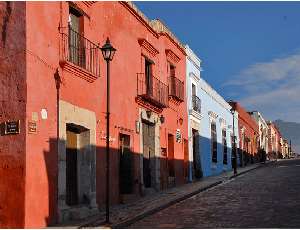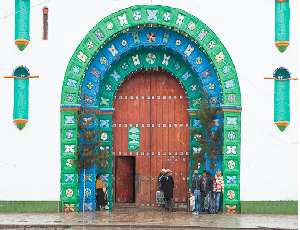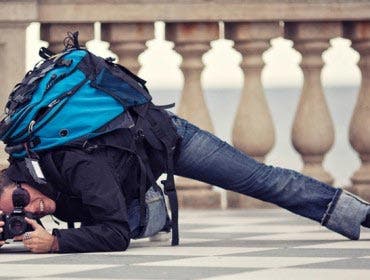When it comes to food, music, and architecture, I must confess I’m no connoisseur. I can say with equal amounts of enthusiasm and ignorance that I know what I like.
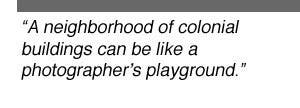 And I like the chocolate chip cookies from Malek’s Bakery, almost any version of “Unchained Melody,” and the colonial architecture of Mexico.
And I like the chocolate chip cookies from Malek’s Bakery, almost any version of “Unchained Melody,” and the colonial architecture of Mexico.
Fortunately, colonial architecture abounds in Mexico. The cities of Taxco, Morelia, San Miguel de Allende, Puebla, Mexico City, Guanajuato, and Oaxaca City all preserve and showcase their colonial architecture.
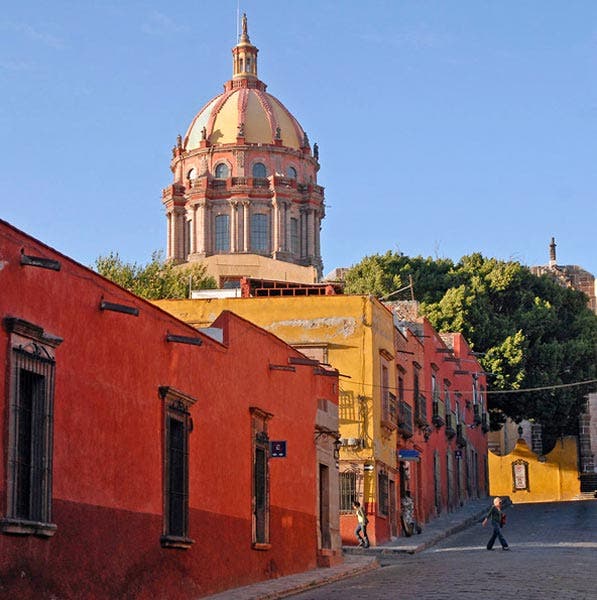
Mexico’s San Miguel de Allende offers blocks and blocks of colorful colonial buildings to photograph.
Distilled to a simple description, Mexico’s colonial architecture refers to the structures built during the time Spain occupied Mexico. That time extended from the sixteenth to the eighteenth centuries. When I researched it for this article terms like neoclassical and Baroque kept showing up. Lacking the in-depth knowledge to explain these terms architecturally, I’ll approach them photographically.
You’ll find fantastic cathedrals and colonial neighborhoods glowing in rich, saturated colors that seem as if they were painted by a Photoshop saturation addict. Some cathedrals explode with ornate detail rich with gold leaf, amazing statues, and incredible wall and ceiling paintings. Overhead towering spires soar and spacious domes expand into the sky. Others, often in small towns and villages, gain quiet respect with their simple designs that seem to offer solace and peace to the downtrodden and distraught.
The colorful colonial neighborhoods, often positioned in a town’s historical center, consist of functional commercial and residential buildings. When struck by sunlight these simple one, two, and three story stucco buildings glow with a variety of colors that seem to imbue and uplift you—if not spiritually then certainly photographically. A refugee from the drab vinyl-sided suburbs of America, my camera starts to vibrate in my hands when these glorious colors begin to radiate it.
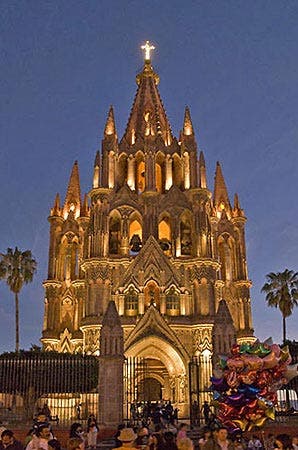
In the town square. San Miguel’s La Parroquia cathedral looks gorgeous any time of day. To handle the mixed and contrasty lighting of twilight use a RAW file format.
Photographing inside a cathedral
The dim interiors of cathedrals can be a challenge. Here’s where the new digital technology of high-quality ISOs and image stabilization really pay off. Even at ISO 1600, you can expect to need a fairly slow shutter speed, such as 1/15 second. If you don’t have an image-stabilized lens (get one-it’s worth it), then steady your camera on a pew or against a wall or door frame. If you did bring a tripod, this will be one of those times you may need it (if its use is allowed).
Some cathedrals, like the Santa Domingo in Oaxaca City, are so amazingly ornate and detailed that you don’t where to start. Begin by exploring the entire church. You’ll often find intriguing side chapels and unexpected religious displays, such as a statue of Mary draped with five-foot long prayer ribbons. Mix in wide-angle shots showing the entire nave with close-ups revealing lit wax-dripped candles by the offering box or the writing on those prayer ribbons.
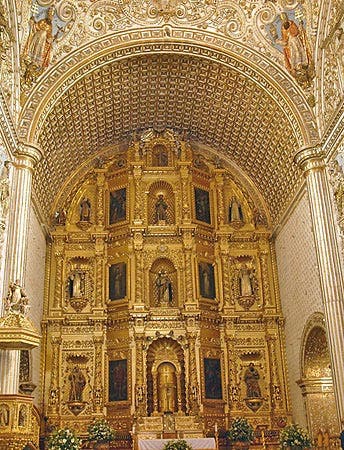
Adorned with gold leaf, carvings, paintings, and statues, the extremely ornate interior of Santo Domingo church in the city of Oaxaca offers hours of photographic potential.
The mixed lighting (skylight, candles, and artificial lights) and contrasty scenes common to many church interiors make it a good time to rely on auto white balance and the RAW file format. If you are an HDR aficionado, now is the time to ply your trade. Before you leave, don’t forget to photograph the sign identifying the church.
Use of flash is usually forbidden. Sometimes tripods are banned, and occasionally even any photography is discouraged. Don’t take pictures during a service, and while inside photographing be respectful of people’s privacy.
Photographing colonial buildings in the centro
A neighborhood of colonial buildings can be like a photographer’s playground. For the camera, it offers its own versions of swingsets, slides, monkeybars, and seesaws that make you want to leap from one to the other. The atmosphere can be as invigorating and stimulating as a playground during a school day recess.
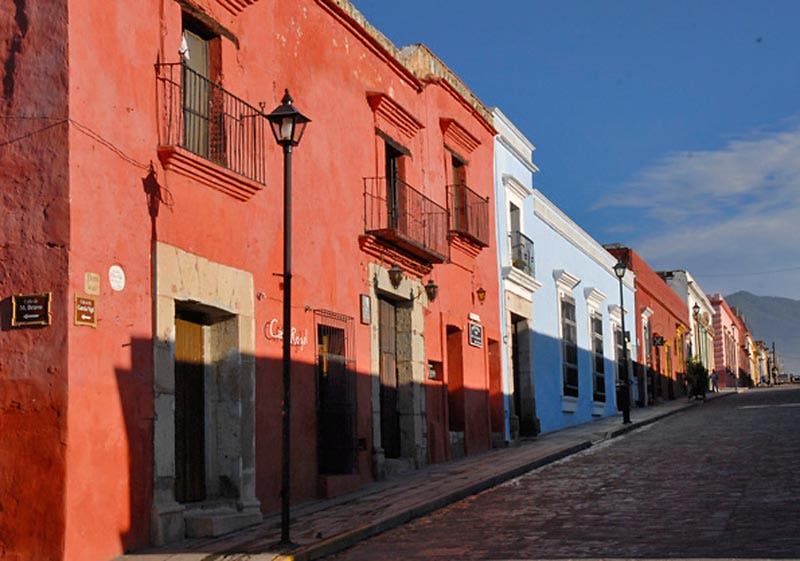
Colonial buildings line the streets near Oaxaca’s Santo Domingo church. Low lighting often provides a nice mix of shadows to enhance the bright colors.
Bright, vibrant oranges, yellows, reds, and blues clamor for your attention. Doors astound not only with color but often with carvings of an artistry that seems to belie the humble abodes into which they open. Cobblestone streets may seem designed to hobble you but line them with these amazing structures and the drama of the scene just keeps building. Add in maroon and scarlet blossoms erupting from bougainvillea branches climbing two and three stories or the occasional enormous clay pot and you’ll begin to wonder which will run out first—your battery or your memory card.
This is a playground that’s open for photography all day. The low sun of morning and late afternoon creates amazing shadows and abstracts for you to play with. Look carefully as early-morning strollers cast amusingly elongated shadows against bright yellow and orange walls.
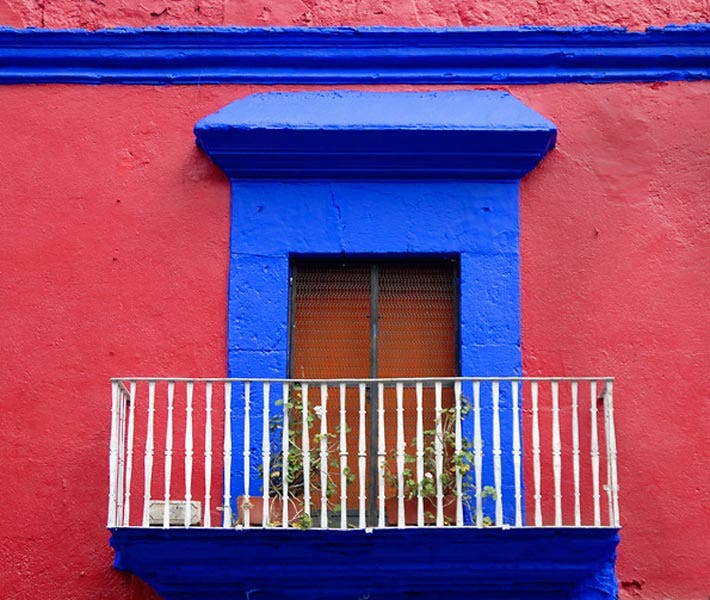
Look for attractive details, such as doorways, windows, and lighting fixtures.
As the day progresses and the sun climbs higher, you may think it’s time to start winding down. It’s not. In other, more pedestrian locales that high mid-morning sun may produce a bland light. Here its work is still unfolding. Around 10 a.m., it has climbed high enough to illuminate all those colorful walls. Walk around to find them, and you’ll be bathed in a shimmering mélange of primary colors reflecting from the brightly painted walls.
If you stand on the shady side of the street, you’ll feel as if someone is holding a giant gold reflector across the street so you can take portraits with fantastic skin tones. And at twilight, when the street and door lights come on, if you can find a perspective to capture them against that mesmerizing cobalt sky, you’ll begin to wonder if you’ve found photographic nirvana.
Unlike in the cathedrals, using auto white balance can be risky. The bright colors could become somewhat diluted by an auto white balance setting confused by them. Of course, if you’re shooting RAW files, you can adjust color to your heart’s content in post-production.

Colorful colonial buildings present you a variety of abstract opportunities.
My first few times in both of these environments was overwhelming. I wanted to photograph everything—immediately. It was just so different from what I was used to that everything seemed unique—even though it was common here. Only after returning several times did I begin to absorb, process, and integrate what I was seeing. Eventually, I began taking pictures that offered a more cohesive and craftsmanlike approach.
Just one more thing: Take lots of memory cards. You’ll need them.
